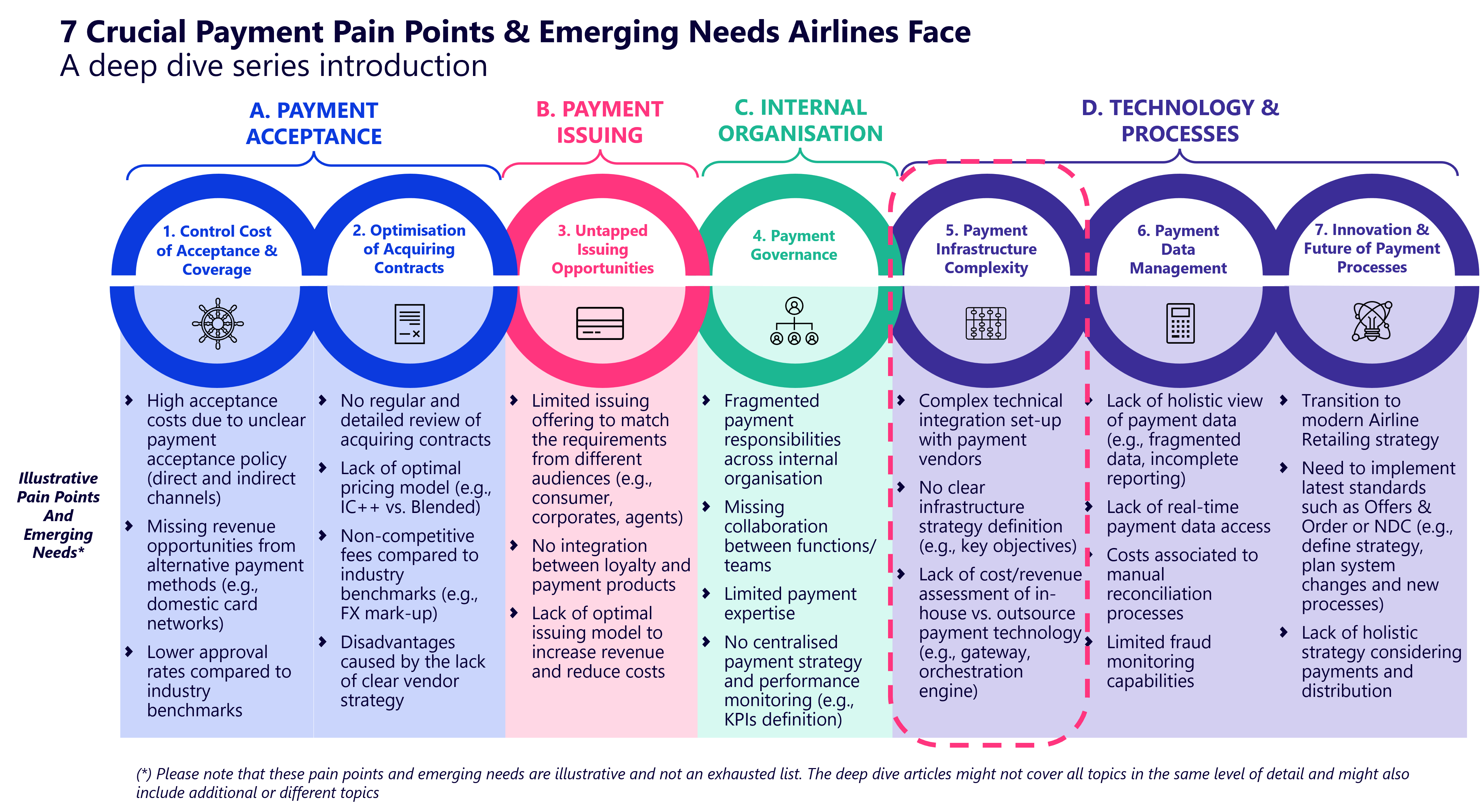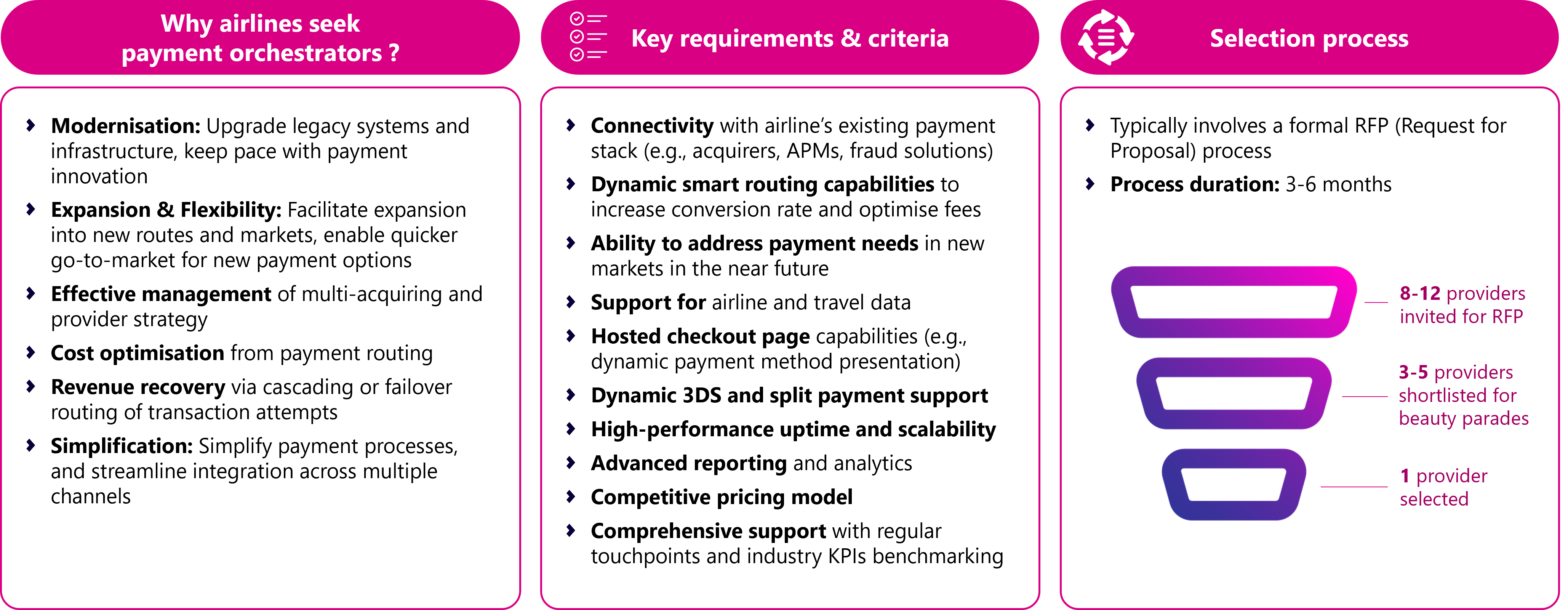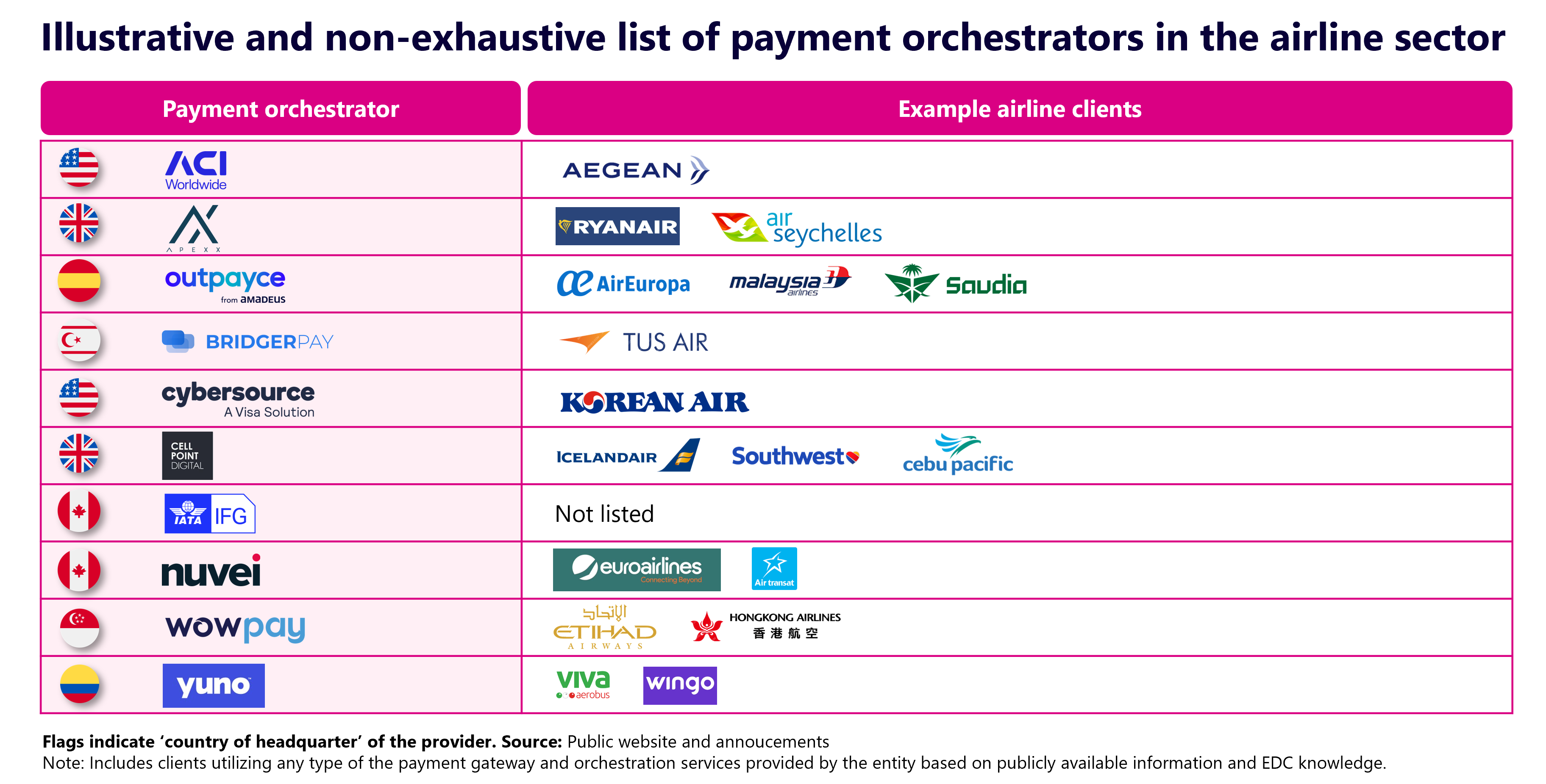Throughout 2025, Edgar, Dunn & Company (EDC)’s travel payments practice continues its deep dive into the evolving role of payments in the airline industry. Our previous articles touched upon the topics of payment acceptance, payment issuing and internal organisation. Building further on these, this article turns to the increasingly intricate and complex landscape of airline payment infrastructure.

The legacy challenge: systems built in silos
Airline payment infrastructure has historically been shaped by necessity rather than strategy. Over time, key systems - such as distribution (GDS, NDC, direct web), PSS platforms, loyalty programs (FFP and partner integrations), payment processing (gateways, acquirers, fraud tools, tokenization), and revenue accounting (settlement and reconciliation), have evolved in isolation. As airlines expanded or adapted to changing market demands, new integrations were layered on, often without re-architecting the core. The result is a patchwork of point-to-point connections between internal systems and external providers - lacking flexibility, accumulating technical debt, and carrying high modification costs. This fragmented architecture now stands in the way of digital transformation. As airlines transition to modern digital retailing models (e.g., migrating to Order Management Systems), it is agility, control, and strategic alignment, rather than integration uptime or cost, that have become essential. One area increasingly under focus is payment orchestration: a technical component that simplifies and centralizes payment routing while addressing deeper infrastructure complexity.
An increasingly complex foundation
This payments-related complexity is more than theoretical, it’s one of the most common operational challenges we encounter in our airline consulting engagements. Beyond core system categories, airlines must manage often tens of specialized payment providers: payment gateways, international and domestic acquirers, fraud platforms, FX services, chargeback tools, 3DS providers, tokenization solutions, and reconciliation systems. Most of these are integrated in isolation, often by different teams, leading to a fragmented view of payment performance and costs.
Several structural challenges commonly emerge:
• Lack of clear alignment between IT and payment infrastructure strategy
• Inconsistent cost-benefit analysis between in-house and outsourced components
• Inflexibility to adapt as business needs change, due to technical risk or long lead times (e.g., multiple months are required to onboard a new acquirer or implement a new payment method)
• Poor visibility into inter-system dependencies and failure points
• Limited ability to extract commercial insights from payment data
Even well-resourced IT teams face delays and risks when updating individual components, especially in legacy environments that lack transparency and testing agility.
The payment orchestration layer
In this context, many airlines have implemented or are considering implementing a payment orchestration layer. Rather than building direct integrations to each provider, an orchestrator acts as a central hub, managing connectivity, smart routing logic, and reporting. This architecture accelerates onboarding of new providers and payment methods, enhances performance monitoring, and enables real-time routing adjustments based on transaction context. Features like cascading retries, where failed payments automatically route to backup processors, boosts success rates and reduce costs. Orchestrators also provide a consistent interface between internal systems (e.g., booking engines, GDS, servicing channels) and diverse external payment technologies. As airlines adopt the Offer-Order model to enable more retail-style experiences, payment orchestration becomes even more critical. It supports complex transaction flows such as split settlements, partial refunds, and synchronization across digital and operational touchpoints, ensuring both flexibility and reliability at scale.

Strategic considerations: in-house or external?
One of the most common questions raised in payment orchestration planning is whether to build the layer in-house or implement an external provider. Some airlines chose to develop internal orchestration tools, particularly those with strong engineering capabilities or tight control over digital platforms. While this approach offers full ownership and customisation, it also introduces ongoing maintenance challenges. Integrating new payment methods, adapting to regulatory changes, or keeping pace with AI-led routing capabilities often requires significantly more resources than initially anticipated. For instance, some airlines with an in-house layer have had to find and retain a team of over 10 developers to set up and maintain such an internal technical component.
By contrast, external orchestration partners typically provide pre-integrated connections to a wide range of payment providers and a growing set of intelligent features. These platforms can reduce implementation timelines and long-term support costs, particularly for airlines with global operations or ambitious roadmaps for payment innovation. However, this model also requires a careful review of vendor fit, technical capabilities (e.g., uptime performance), data compatibility, and long-term flexibility. The decision between internal and external orchestration is ultimately strategic and depends on the unique position of each airline. Airlines must assess not only the technical scope but also the operating model, investment priorities, and expected future pace of change across their retail and payment strategies.

Understanding the state of “smart routing”
A frequent promise of payment orchestration is the ability to intelligently route transactions, whether to optimize costs, improve authorization rates, or reduce fraud risk. In practice, however, the definition and maturity of smart routing vary significantly across providers. Many orchestration platforms today rely on static, rule-based logic, with parameters configured either by merchants through self-service dashboards or, in some cases by the provider. In our experience, airlines often underestimate the ongoing effort required to maintain and optimize these routing rules. For example, quarterly fee updates may necessitate adjustments to maintain cost efficiency. These rules can be based on geography, point of sale (POS) location, card scheme or type, BIN, currency, or other transaction attributes. While effective in early stages, such static rules typically require manual updates and cannot adapt to real-time changes in performance. A smaller group of orchestration providers are now beginning to offer more dynamic capabilities, including routing decisions informed by historical authorization data, transaction cost benchmarks, and AI-based predictions. Some platforms are also starting to incorporate and ingest settlement data to refine future decisions. Although these advanced features are not yet widespread, they represent an important evolution as payment orchestration moves from a tool of operational efficiency toward a driver of true commercial intelligence.
Cost considerations and commercial models
Pricing models for orchestration vary depending on the provider and the level of service. Airlines may encounter per transaction fees (X cents per transaction), one-time implementation charges (can exceed $10k), and integration costs for custom connections (wide range depending on providers). Some platforms include fraud tools, 3DS or tokenisation services within their base offering, while others separate these into modular add-ons and charge accordingly. In general, costs are tiered by transaction volume and feature set, with bundled models more common among larger airlines or multi-brand groups. Beyond direct costs, airlines should consider the indirect impact on internal resources, time-to-market, and risk exposure. In many cases, the total cost of ownership of an orchestration layer - whether internal or external - must be measured against the operational friction it is designed to reduce.
Don’t forget pay-outs
While most orchestration discussions focus on accepting payments (pay-ins), the complexity of customer payments is mirrored on the supplier / pay-out side. Payments to or from consolidators, OTAs, fuel vendors, and other partners often run through separate systems or manual workflows, creating inefficiencies, limiting visibility, and complicating reconciliation. Payout orchestration is emerging as a distinct layer to address this gap. Platforms like FinMont and Outpayce are helping travel companies automate B2B partner settlements, manage multi-currency payouts, and integrate with treasury systems, often delivering fast ROI.
From simplification to strategy
The transformation underway in airline payment infrastructure reflects a broader shift in how carriers approach technology investment. Payment orchestration is no longer just a middleware solution. For many airlines, it is becoming a structural enabler that supports faster innovation, better alignment across internal teams, and more consistent payment experiences across customer touchpoints. It also lays the groundwork for stronger governance, clearer performance monitoring, and more effective long-term planning.
Airlines implementing orchestration effectively are seeing benefits that go beyond technical efficiency: real-time visibility into payment performance across markets, the ability to test and deploy new payment methods without adding technical debt, and most importantly, the commercial insights needed to optimize both costs and conversion. With global airline passenger numbers expected to exceed 5.2 billion in 2025 and industry net profits projected at 3.1% margins, even small gains in payment efficiency can have a significant financial impact. In a margin-sensitive industry, a 1 percent improvement in payment conversion can translate into millions in recovered revenue, giving first movers a clear competitive advantage.
Stay tuned for upcoming articles in this EDC series, where we’ll continue exploring two additional pillars of “payment technology”: payment data management and innovations in payment processes, both critical to supporting broader goals in the airline industry.
Reach out to us at travelpayments@edgardunn.com to share your thoughts on this article or to arrange an exploratory call to discuss opportunities within airline payments.
The content of this article does not reflect the official opinion of Edgar, Dunn & Company. The information and views expressed in this publication belong solely to the author(s).
Rohan is a Consultant in the Paris office. Before joining EDC, Rohan worked 3 years in India and France across technology strategy and transformation projects. Since joining EDC in 2023, he has gained valuable payment strategy expertise working with global card networks, issuers, fintech’s and travel merchants. Rohan holds a Masters in Management from ESSEC Business School in Paris, alongside an Electronics Engineering degree from India. Outside the realm of consultancy, Rohan follows cricket, football, and Formula 1. Additionally, he finds solace in activities like cooking, yoga and skateboarding.
.webp)
%20(1).webp)

%20(1).webp)
.webp)



